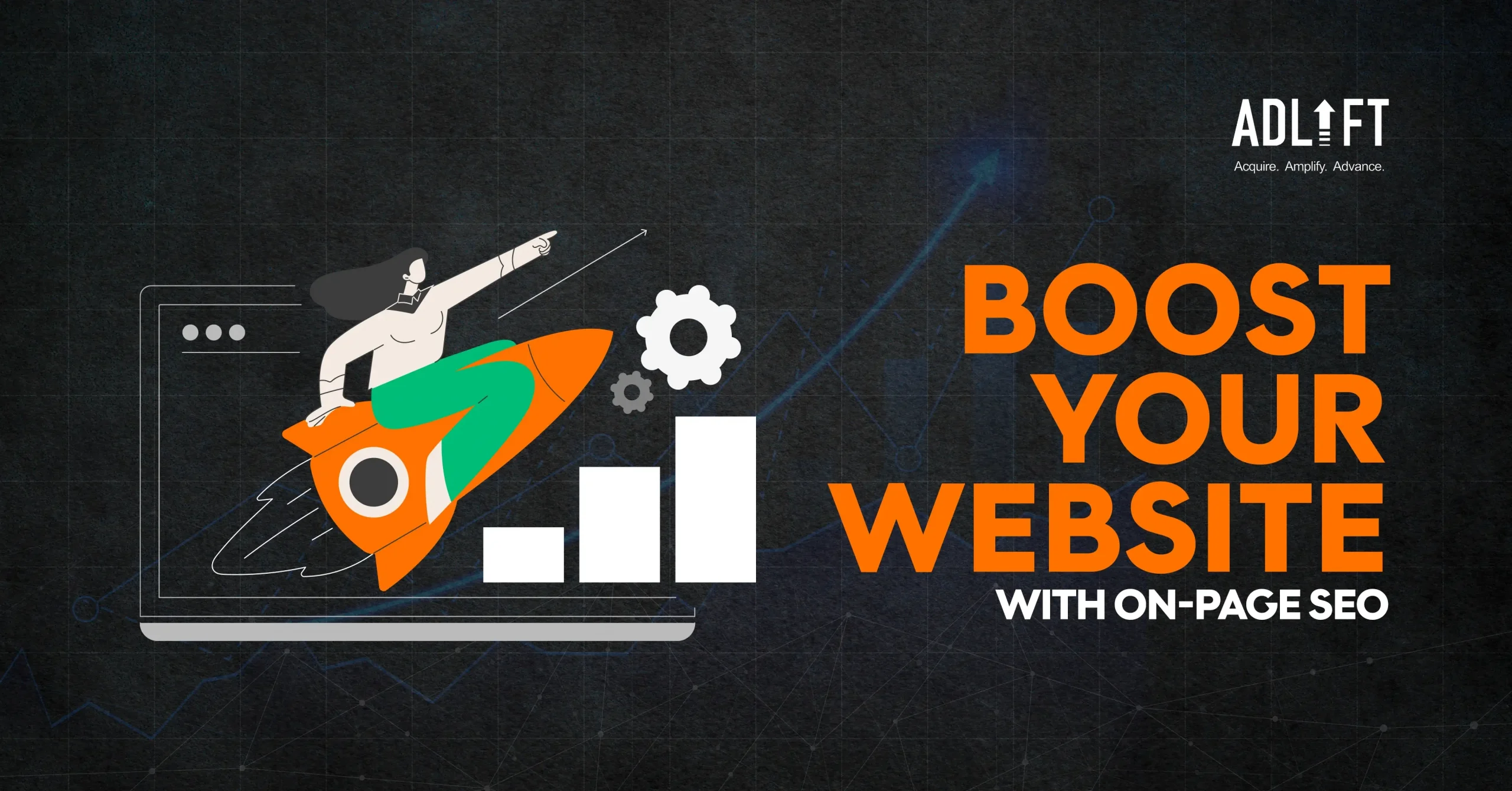What is On-page SEO and How Does it Impact Your Website?

If you’ve ever thought that being at the top of Google’s search results is just luck, think again. Behind every top-ranking website is a whole strategy called SEO (Search Engine Optimization). It’s like knowing the secret code to get noticed online. And once you crack it, it’s like second nature. So, if you want your business to shine online, and understand how to get top in Google search results? Then mastering SEO is key.
What is On page SEO?
Onpage SEO, as the name suggests, involves refining individual pages on your website to boost their ranking or scale on Search Engine Result Pages (SERPs) for specific keywords. These onpage optimizations can be both visible and hidden, aimed at attracting more relevant traffic to the page. The more pages you optimize across your site, the more robust your SEO strategy becomes, flexing your website’s muscles in the digital arena.
What is On Page Optimization?
Onpage SEO optimization is the pillar of any effective SEO strategy. It refers to the method of optimizing individual web pages to rank higher and earn more relevant traffic in search engines. This involves various techniques, such as optimizing title tags, meta descriptions, headers, and content with relevant keywords.
Additionally, ensuring proper URL structures, internal linking, and optimizing images are a few on page SEO examples. Onpage optimization also entails improving user experience by making the website faster, mobile-friendly, and easy to navigate.
By focusing on these aspects, businesses can easily answer the question: how to do on page SEO? The onsite SEO strategies improve online visibility, attract qualified leads, and enhance the website’s performance in the metrics of Search Engine Result Pages (SERPs).
Onpage SEO Checklist
Listed below are the 11 elements of the onpage SEO checklist. Familiarizing yourself with these elements will illuminate their significance in achieving improved rankings through onsite SEO.
- Keyword Research: Keyword research is the foundation of onpage SEO. It involves identifying and analyzing the specific terms and expressions users type into search engines. By understanding these keywords, businesses can create content that aligns with user intent and targets relevant search queries, thereby increasing their chances of ranking higher in search engine results.
- Content Quality: High-quality content is vital for engaging users and satisfying search engine algorithms. Content should be relevant, informative, and well-written to provide value to readers. It should also address the needs and interests of the target audience while incorporating targeted keywords naturally.
- Keyword Placement: Strategic keyword placement throughout the content helps search engines identify and understand the topic and relevance of the page. Keywords must be used in the title, headings, body paragraphs, meta description, and URL to signal the page’s content to search engine crawlers effectively.
- Images: Optimizing images is crucial for enhancing user experience and improving page load times. Images should be relevant to the content, properly labeled with descriptive filenames and alt text containing targeted keywords, and compressed to reduce file size without compromising quality.
- Title: The title tag is one of the most critical onpage SEO elements. It should correctly reflect the content of the page, include primary keywords, and entice users to click through from search results. Titles should be concise, compelling, and within recommended character limits.
- Headings: Proper use of headings (H1, H2, H3, etc.) helps structure content and improve readability. Headings should be hierarchical, with the primary heading (H1) indicating the main topic of the page and subsequent headings organizing subtopics. Keywords can be included in headings to reinforce topical relevance.
- Meta Description: These are not a direct ranking factor, but they play a key role in inviting clicks from SERPs. Descriptions should be concise and engaging and involve relevant keywords to attract users to click through to the page.
- URL: A clean, descriptive URL structure enhances both user experience and search engine visibility. URLs should be short, readable, and include targeted keywords when appropriate. Avoid using unnecessary parameters, symbols, or dynamic URL strings that can confuse both users and search engines.
- Links: Internal linking helps search engines explore and index other pages on the website, while external linking to authoritative sources can improve the credibility and relevance of the content. Links should be natural and relevant and add value to the user experience.
- Technical: Technical aspects such as page speed, mobile-friendliness, schema markup, and canonical tags contribute to overall site health and SEO performance. Ensuring proper technical optimization helps search engines crawl, index, and rank pages more effectively.
- Fresh Content: Regularly updating content demonstrates relevance and authority to search engines. New content signals that the website is actively maintained and provides users with up-to-date information. Updating existing content, publishing new articles, and engaging with user-generated content can help maintain content uniqueness and improve SEO performance.
Impact of Onpage SEO on Your Website
- Enhanced Visibility in Search Engine Results Pages: Onpage SEO boosts your website’s visibility in SERPs by optimizing various elements like titles, meta descriptions, and headers with relevant keywords. When your website ranks higher in SERPs, it’s more likely to be seen by users searching for related topics or products, increasing the chances of attracting organic traffic and potential customers.
- Enhanced User Experience and Engagement: Effective onpage SEO service improves user experience by providing valuable, well-structured content that matches user intent. By optimizing page load times, mobile responsiveness, and navigation, visitors are likely to stay on your site longer, explore different pages, and engage with your content. This helps improve user satisfaction while signaling to search engines that your website offers useful information, potentially boosting its rankings.
- Higher Conversion Rates: Optimizing onpage SEO services such as Calls-to-Action (CTAs), forms, and product descriptions can lead to higher conversion rates. You can align your content with user demands and preferences and make it easy for visitors to take desired actions. With this, you increase the likelihood of turning website visitors into customers or leads.
- Long-term Sustainability and Growth: Investing in onpage SEO lays the foundation for long-term sustainability and growth for your website. By continually updating and optimizing your content, staying abreast of algorithm changes, and adapting to evolving user behavior, you can maintain and improve your website’s visibility, relevance, and authority over time. This sustainable approach helps you withstand fluctuations in search engine rankings and position your website for continued success and growth in the competitive online landscape.
Boost Your Business Using Onpage SEO Methods
Onpage SEO is a fundamental aspect of digital marketing that significantly impacts the visibility and performance of your website in search engine results. To take your website’s SEO to the next level and maximize its impact on your business, consider partnering with Adlift. Our team specializes in curating tailored SEO strategies designed to elevate your website’s performance and drive tangible results. Contact us today to learn more about how Adlift can help you achieve your digital marketing goals.
FAQs
Onpage SEO optimization is pivotal in SEO strategies, as it directly influences search engine rankings and user experience. By fine-tuning various elements on your website, like title tags, meta descriptions, headers, images, and more, you can enhance visibility, relevance, and credibility, ultimately driving better performance.
Among the array of onpage SEO elements, your website’s page titles (or title tags) reign supreme in importance. These titles serve as vital cues for both visitors and search engines, indicating the content and purpose of each page. To ensure optimal ranking and alignment with search intent, incorporating the focus keyword for each page into its title is crucial.
The ideal keywords to target are those closely aligned with your content and audience needs. Effective keywords should address queries, solve problems, or offer value to your target demographic, ensuring relevance and engagement with your content.
Raw traffic in SEO stems from optimizing websites for search engines and crafting content tailored to specific keywords. This optimization facilitates ranking for key search terms, resulting in increased direct traffic and referral links as more users discover, engage with, and derive value from your content.
SEO success hinges on several key factors, including optimizing for the search experience, prioritizing content for human consumption rather than search engine algorithms, and adapting strategies to accommodate emerging trends like voice search. By focusing on these things, businesses can enhance their online presence and drive sustainable growth.
Recent Posts
- Reaching Your First 5k Followers on YouTube: Strategies for Success April 29, 2024
- Saying Goodbye to Twitter: Steps for Deleting Your Account April 29, 2024
- Step-by-Step Guide: How to Delete Your Instagram Account April 29, 2024
- Maximizing Google Product Listing Ads: Tips for E-commerce Success April 29, 2024
- Crafting an Effective SEO Strategy: Key Steps for Success April 29, 2024
- Go Viral in Seconds: How to Upload a YouTube Short? April 17, 2024
- Multi-Channel Mania: Mastering Distribution Channels to Reach Customers Everywhere April 12, 2024
- From Product to Promotion: A Fresh Take on the 4 Ps of Marketing April 12, 2024
- Is Your Marketing Paying Off? The Ultimate Guide to ROAS April 12, 2024
- Understanding HTML Sitemaps: A Key Component for Website Structure April 12, 2024
Get
in Touch
Contact AdLift for a 360-degree marketing plan

